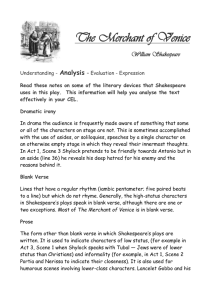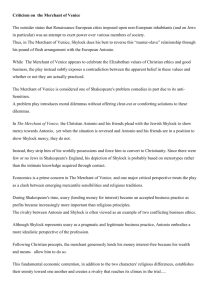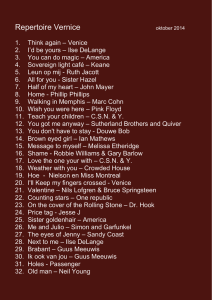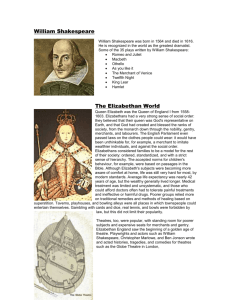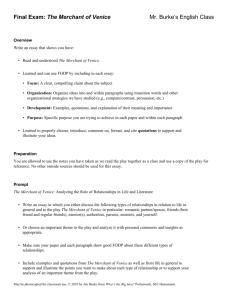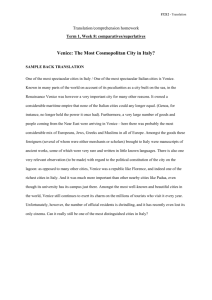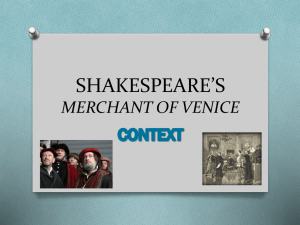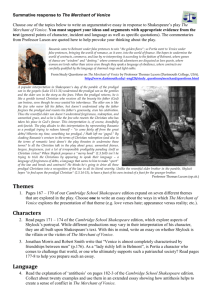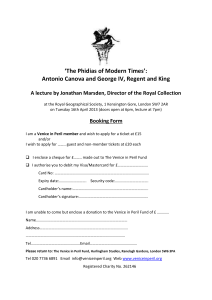the MERCHANT OF VENICE - Elements Theatre Company
advertisement
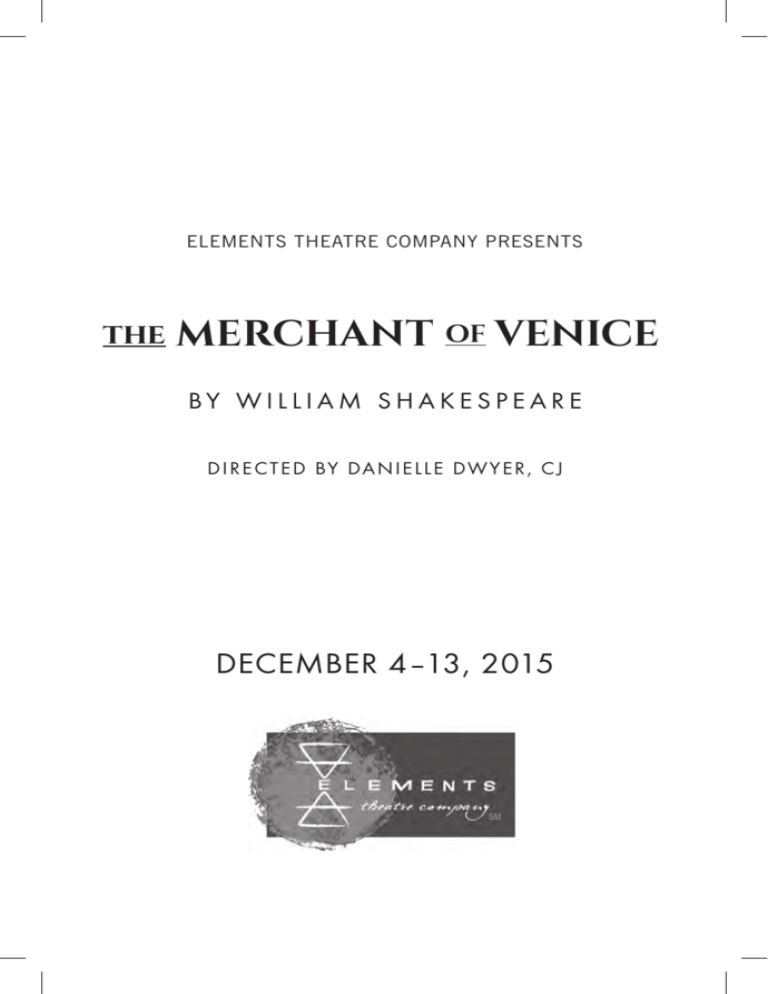
ELEMENTS THEATRE COMPANY PRESENTS the MERCHANT OF VENICE BY WILLIAM SHAKESPEARE DIRE CT E D BY DA NIE L L E DW YER, CJ DECEMBER 4–13, 2015 SM THE MERCHANT OF VENICE The Merchant of Venice, believed to have been written between 1596 and 1598, was written after Shakespeare’s Titus Andronicus, Romeo and Juliet, and Richard III, but before the great tragedies that followed them— Julius Caesar, Othello, and King Lear, for example. But why should The Merchant of Venice find itself discussed among a group of Shakespeare’s tragedies? The fact is that they have much in common. The Merchant of Venice, although one of Shakespeare’s comedies, has as its main character a tragic hero, Shylock, who by virtue of a fatal flaw loses everything dear to him—his fortune, his daughter, the practice of his religion, even his cultural identity. All around Shylock, Shakespeare created a group of far less complex characters, characters about whom he reveals much less and about whom many questions remain unanswered. For example, we never learn why the merchant Antonio is so sad at the beginning of the play, though we come to assume that he is already mourning the loss of his close friendship with Bassanio, who is in pursuit of his new love, Portia. Shakespeare tells us little more about Antonio than that he is wealthy, has ships at sea, and that he regularly rails at Shylock in the marketplace, spitting on him and even kicking him before all who pass by. By contrast, Shakespeare invites us into Shylock’s mind by soliloquy, and later into his home where we observe Shylock’s relationship with his daughter, Jessica, and see how he seeks to protect her and her Jewish heritage from what he believes are the decadent practices of the Christians in Venice. We learn about his servant, his frugality, his friends, his house, and that he fondly remembers his deceased wife, Leah, and still treasures the ring she gave him during their engagement. We learn that he stands against his natural inclination to lend money to Antonio, and we learn why he hates Antonio. On the other hand, we never become privy to any reason for Antonio’s hatred of Shylock. What does Shakespeare reveal about Bassanio, except that he is a spendthrift and that he is willing to risk his friend’s money and life to finance his own passions? And of Portia we learn only that she is wealthy, beautiful, and virtuous, that she is bound by her deceased father’s will, and that she seems to hold all but one of her suitors in disdain. At the beginning of the play she is not unlike Antonio, for she tells us she is www.elementstheatre.org 7 “aweary of this great world.” Finally we learn that Shylock has a breaking point, and when he feels sufficiently injured, he abandons his principles, embraces his pursuit of revenge, and is no longer able to love or offer forgiveness. Until then it is hard not to sympathize with him, as we might also do with Othello, another of Shakespeare’s characters who was seen as the “other” and who succumbed to vengeance. Perhaps Shakespeare is offering us insight into his own experience when we consider the passions and energies that drive the action of this play. Among the passions we first encounter is romantic love. When Bassanio applies to Antonio for help to finance his suit of Portia, Shakespeare leaves us no doubt that Bassanio’s passion for Portia has consumed him. Later, when Shakespeare introduces the ardor between Jessica and Lorenzo and when the love of Nerissa and Gratiano blooms, it is clear that romantic love is one element that drives the play. Certainly the question of wealth and the need for money drive the story. In the first scene, it is the state of Antonio’s fortune at sea and Bassanio’s needs that force the men to seek money from Shylock. Even the first words Bassanio uses to describe Portia involve money, for he tells Antonio that she is “a lady richly left.” Jessica and Lorenzo seem to have no difficulty appropriating Shylock’s wealth when they elope. When the threat of Shylock’s wrath turns Antonio’s “merry bond” deadly, it is Portia’s means that Bassanio takes with him to Venice to try to finance Antonio’s rescue. Later, it is Shylock’s confiscated wealth that leads to the financial security that Jessica and Lorenzo will come to enjoy at his death. Finally, to secure the happy ending, Portia’s letter from Bellario reveals that Antonio’s lost argosies have safely arrived at port and his fortunes are secure. What about hatred and revenge? There is mutual animosity between Antonio and Shylock, but it has a strangely impersonal character. Shylock admits that he hates Antonio “because he is a Christian” and because Antonio’s practice of lending money gratis hurts his business. Antonio has abused Shylock in the marketplace, but only because he is a Jew and practices usury. Even while negotiating the loan he seeks from Shylock, Antonio promises further abuse. Shylock seems able to endure such a future, and the inevitable painful coexistence with Christians that it has in store for him. However, when his daughter betrays him, robs him, and flees Venice to marry a Christian, Shylock’s outward forebearance turns 8 STORY IMAGINATION AUTHENTICITY to hatred and demands revenge. Certainly hatred and revenge are driving elements in the play. However, in the end, it is the question of power that the characters have in common. Antonio is sad because he has no power to prevent the eclipse of his relationship with Bassanio once his friend has begun his pursuit of Portia. Bassanio lacks the means, and thus the power, to forward the suit for his love. Portia lacks the power to choose or to refuse a suitor who would be her husband, being “hedged” from the grave by her father’s will. Jessica shakes off the power her father wields over her and steals the power his fortune holds when she and Lorenzo run away. In his impotent rage at his daughter’s flight, Shylock swears to enforce the power of Antonio’s bond, an act of rage the city of Venice seems powerless to thwart. It is only her newfound knowledge of the law—and knowledge is power—that enables Portia to build a case strong enough to overcome Shylock’s rage. In the end, the Duke invokes the one power greater than the Venetian law, the power of mercy that mitigates and tempers the letter of the law, and mercy leads to a degree of forgiveness. Shakespeare is not done yet, though. At Belmont Portia and Nerissa execute one last power play, a game that brings Bassanio and Gratiano to their knees, but it, too, ends when mercy prevails and peace comes to their new marriages. There are other examples, but it is interesting to note that Shakespeare empowers only one character to singlehandedly escape the constraints that deny him the power to determine his own destiny: the clown, Launcelot, who early in the play banishes the power of his conscience and leaves his master, Shylock, in hopes of entering into Bassanio’s service. The London of Shakespeare’s time bears striking similarities to the Venice where he set both his plays that specifically deal with the “other”— Othello and The Merchant of Venice. Like Venice, London was a thriving city whose wealth and commerce brought the whole world to its door, and it was also a city known for the strength of its law. But beyond the similarity of their flourishing economies and cultures, London and Venice were also cities where religious differences could prove life-threatening. When the play was written, the strife between the Catholics and Protestants during the reign of “Bloody” Mary had not been forgotten. Elizabeth’s re-establishment of the Church of England made her the target of enemies within and without England, and she ordered her own share www.elementstheatre.org 9 of executions. In a country where Christians persecuted and killed other Christians, being the “other” sometimes depended on where you lived. There remained Catholic strongholds in the north, which, in the name of peace, Elizabeth was loathe to challenge. But despite the differences that caused deadly tensions among Christians in England, Jews were always outsiders, as they had been in Venice where they suffered many indignities and were forced to live in an island ghetto, and where ungrounded suspicions sometimes cost them their lives. ABOUT VENICE In the early years of the fifth century ad, following the collapse of the Roman Empire, barbarians sweeping down from northern Europe forced mainland Italians to seek refuge in the Venetian Lagoon, where their enemies could not follow. According to tradition, Venice formally came into existence at the stroke of noon on the 25th of March, 421 ad, but it wasn’t until around 450 ad that large numbers of people decided to settle in the lagoon permanently. Those who settled there found that living in a refuge was enviable, because their enemies, lacking both ships and a knowledge of the sea, could not follow. For nearly 1400 years, the two or three miles of shallow water separating Venice from mainland Italy not only protected Venice from invaders but effectively isolated the Venetians from Italian political life. Untouched by papal and imperialist warfare, feudalism and territorial squabbles, they turned their attention toward the East and the rich markets of the Levant and Constantinople, the Byzantine Empire and the Muslim world. The Crusades brought intensification of trade, and Venice soon ranked first among the trading nations. Thus began the great mercantile empire of the world’s longest existing republic—the Venetian Republic. From the time of the establishment of the Republic in 697, it was known as Most Serene Republic of Venice or Serenissima Repubblica di Venezia. San Marco Basilica was constructed as a home for the bones of St. Mark the Evangelist, whose remains were stolen from Alexandria, Egypt, by two Venetian merchants who smuggled the saint’s bones past Muslim customs officials by stuffing them into a barrel of pork in 828 ad. After 200 years or so in temporary quarters, the Evangelist’s bones were moved to the new Basilica di San Marco (the third church on the site) when it was completed 10 STORY IMAGINATION AUTHENTICITY about 1071 ad. It became Venice’s cathedral in 1807 after hundreds of years as a state church and chapel under the authority of the Doges. A century before the fall of Constantinople in 1204, the Venetians conquered Crete and formed a colonial empire that established a background of free trade, with convoys of large ships sent to the markets around the Mediterranean Sea. Wheat was an important commodity, followed later by the production of fabrics, silk, and glass. The salt monopoly was of the utmost importance along with ship building. The city could finance its everyday duties by revenues from tariffs, but in hard times it helped itself to the estate and capital of its many rich families. Money in those days consisted mostly of gold and silver, which are hard to transport over long distances, so crediting became the way to accelerate the turnover of goods. During the late thirteenth century, Venice was the most prosperous city in all of Europe. A city built upon the fear of barbarian invasion was to be heralded as the most dazzlingly beautiful city in the world. While the Florentines were regarded as great thinkers, the Venetians are regarded as great doers, for they alone conquered the malaria-ridden swamps to build a city from nothing. At the peak of its power and wealth, Venice boasted 36,000 sailors operating 3,300 ships, dominating Mediterranean commerce. In the late fourteenth century the rivalry between Venice and Genoa exploded into war, but Venice was the victor and retained mastery of its maritime empire. A territorial empire was begun with the conquests of nearby Padua and Verona in 1405. By 1454, Venetian conquests reached far west on the Lombard Plain of northern Italy to Bergamo and Crema, almost to Milan, and northeast along the arc of the Adriatic Coast to Friuli and beyond to Dalmatia or what is modern Croatia. These territories included wealthy trading centers, drawing on the fertile lands bordering the Po River, and gateways to the passes over the Alps. During this period from 1300–1499, known as the Italian Renaissance, Venice’s leading families vied with each other to build the grandest palaces and support the work of the greatest and most talented artists. In 1315, the Venetian Golden Book of the Nobility was published, listing the names of the most influential families in the city, allowing them membership in the Great Council and disenfranchising all others. In 200 years this list changed very little and only after great deliberation. In other words, the www.elementstheatre.org 11 society was stable, but even so the lower classes had little to complain about for many of the Venetian nobility were neither excessively wealthy nor oppressive, but rather hard-working businessmen of varying degrees of success. The city was governed by the Great Council, which was made up of members of the most influential families in Venice. The Great Council appointed all public officials and elected a Senate of 200–300 individuals. The Senate then chose the Council of Ten, a secretive group which held the utmost power in the administration of the city. One member of the great council was elected “doge” or duke, the ceremonial head of the city. He ruled for life in great splendor, under a system of constitutional monarchy. Laws were passed in his name, but his power was severely limited by the Great Council, and most notably by the Council of Ten. Throughout the late fifteenth and early sixteenth centuries, Venice was assailed at sea by the Ottoman Turks, who had conquered Cyprus, and on land by the so-called Holy League, which sought to knock Venice from its pedestal of arrogance. The city survived the onslaught by relying on its strength in sea trade. By this time Venice had become a cosmopolitan city with flourishing Greek, Armenian, Albanian, and Jewish communities. By 1490 Venice had a population of 180,000 people, but in 1499 war began with the Ottomans. By 1581 the population of Venice was down to 124,000 due to the wars and the plague. From 1645–1660 the Cretan war continued with the Ottoman Empire, ending with Crete falling under Ottoman rule for three centuries. 1714 marked the end of the Venice–Turkish conflicts, and by 1792 the merchant fleet had declined to 309 merchant men, four galleys, and 7 gaillots. Napoleon invaded Venezia and on May 12, 1796, the last Doge, Ludovico Marin, surrendered unconditionally and abdicated. Venice was one of the few places in Europe where Jews were allowed to live and trade. They were legally banned from England in 1290. Jewish people immigrated to Venice by the thousands, many of them moving to Mestre. With the founding of the Ghetto or “gheto” in 1516, most Jews moved there. Nowadays ghettos have negative connotations, but in Shakespeare’s time the Venetian “gheto” was a place of salvation. It was surrounded by canals with bridges that were raised and guarded at night. When Napoleon captured the Venetian Republic in March of 1797, he 12 STORY IMAGINATION AUTHENTICITY removed the gates of the ghetto and ended restrictions on where Jews could live and travel. At the time in which Shakespeare (1564–1616) lived and was writing, Venice was one of the most important sovereign states in Italy. In 1600 its area and population size was comparable to London’s (about 150,000 inhabitants) and, due to its key importance in maritime traffic in the Mediterranean, it also constituted a melting pot of different cultures, attracting, among others Turks, Greeks, Spaniards, Slavs, Jews, Moors and, of course, Englishmen. Its major banking system confirmed Venice as the richest and most abundant city in the world. The city received profits not only through trade, but also through heavy taxation, with huge revenue coming from the Jewish community, which practiced usury. There were no political relations between Venice and England during the long reign of Queen Elizabeth (1533–1603). The English viewed Venice with a mixture of admiration and skepticism, but the stability of the Venetian Republic stood in sharp contrast with the uncertainties that surrounded the exclusive, hierarchical order that characterized early modern England. Venice was also viewed by England as a competitor in trade. Two Charters issued in 1592 and 1600 gave the monopoly of the trade between England and Venice to a group of London merchants. Therefore, it is likely that Shakespeare wrote his two plays set in Venice, The Merchant of Venice and Othello, in a period when the English were greatly interested in the Italian Republic. Italy was a place where anything could happen. VENICE TODAY Venice, as the capital of the Veneto region, is a world heritage site known for the beauty of its setting, its architecture, and artwork. The New York Times has acclaimed it the most beautiful city in the world. Its economy is based on tourism, with 50,000 visiting tourists a day, and almost three million a year. The population of the commune is estimated at 280,000, but only 60,000 reside in the historic city of Venice. The population is 91% Italian and 92% are Roman Catholic, but a Jewish community remains today in an area where there are five synagogues blessed by a relaxed, peaceful atmosphere that still feels a bit removed from the rest of Venice. www.elementstheatre.org 13 ABOUT THE SET An antique map of Venice serves as the foundation for the set. Surrounded by water, Venice’s narrow alleys, canals and arched bridges have remained largely unchanged over the centuries since Shakespeare wrote The Merchant of Venice. Local travel is still largely by boat or on foot, major commerce by sea. Warm colors and ornate facades speak of the optimism and adventurism of the merchant class, and also of the cosmopolitan nature of this trading center, a bridge between east and west. The repeated, standardized facades (like the well-known Venetian masks) hide the darker side of a city habitually luxuriating in its greed and excess. Perhaps we should expect this of a city whose principal religious structure houses the bones of Saint Mark, bones which were stolen from Alexandria in the ninth century by the same merchant class that built the city itself. As described by John Ruskin, Venice architecture is “Pagan in its origin, proud and unholy in its revival, paralyzed in its old age … an architecture invented as it seems, to make plagiarists of its architects, slaves of its workmen, sybarites of its inhabitants.…[Its] intellect is idle, invention is impossible, but in all, luxury is gratified and all insolence fortified.” [“The Stones of Venice,” 1853]. The architecture displayed here embodies both the city’s commercial priorities and its rules, rules which are absolute, unmoving, and inflexible. A gate stands stage left, symbolic of the barricade of the Jewish ghetto and the separation, curfew, and rules that apply to its inhabitants. It is both a witness of and a participant in the clash of cultures that is about to unfold. 14 STORY IMAGINATION AUTHENTICITY
